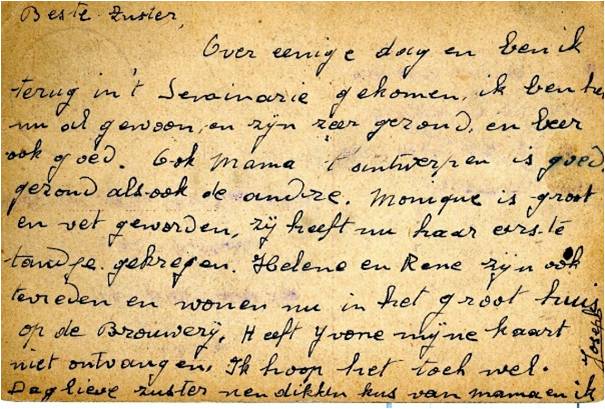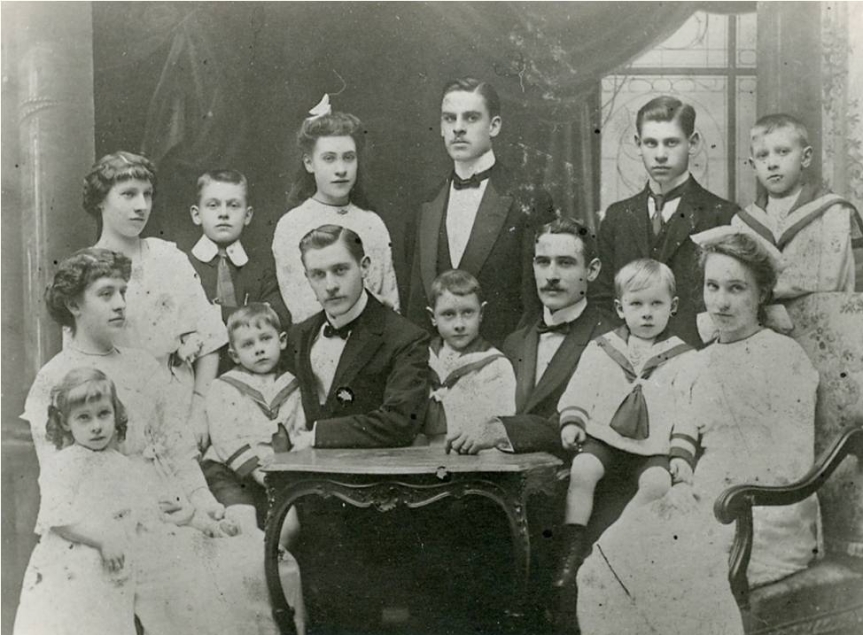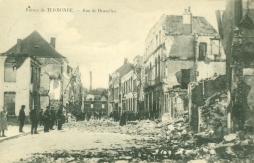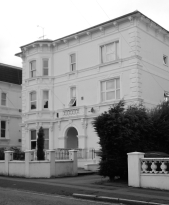It is a pity that we no longer have the complete correspondence to and from the Boeynaems family who fled to England during WW1, especially as the letters sent from the refugees’ addresses in England may contain important material. But that exchange of letters has not yet been found. Only seven letters and a dozen postcards, all sent to England, have been preserved. This was enough to make up a puzzle, one with many missing pieces. No full story, rather a list of events and locations.
At the outbreak of the First World War the family of Florent Boeynaems and his wife Marie Coosemans had 14 children. They lived in Antwerp at no 5 Prinsstraat. By profession father Florent Boeynaems was a notary.
|
Florent Boeynaems X Marie Coosemans 1860-1915 1866-1946 |
|
| Their children | Age in 1914 |
| Ferdinand (Fernand) 1889-1918 | 25 |
| Paul 1891-1958 | 23 |
| Hélène 1892-1944 | 22 |
| Hubert 1893-1961 | 21 |
| Marthe 1895-1940 | 19 |
| Jean (Jan) 1897-1969 | 17 |
| Suzanne 1898-1982 | 16 |
| Yvonne 1900-1986 | 14 |
| Florent (Flor) 1901-1980 | 13 |
| Pierre (Piet) 1903-1986 | 11 |
| Joseph (Jos) 1906-1984 | 8 |
| Marie Louise (Mimi) 1908-2004 | 6 |
| Jacques (Jaak) 1909-1995 | 5 |
| Ludovic 1910-1996 | 4 |
Mother Marie Coosemans was the half-sister of Florent Coosemans, chairman of the Club Albert in Tunbridge Wells during WW1. Florent Coosemans was married to Louise Martin. His father Ferdinand Coosemans married twice. His first wife passed away shortly after Marie Coosemans’s birth in 1866.
|
Ferdinand Coosemans 1°X Maria Van Welde 1828-1926 1829-1866 |
|
| Their children | Married to |
| Constant Coosemans 1861-1923 | Marie Van Goethem |
| Marie Coosemans 1866-1946 | Florent Boeynaems |
|
Ferdinand Coosemans 2°X Anne Cornélie Van de Wiel 1828-1926 1836 – 1906 |
|
| Their children | Married to |
| Caroline Coosemans 1871-1959 | Charles Cnoops |
| Florent Coosemans 1872-1947 | Louise Martin |
| HortenseCoosemans 1873-1935 | Felix Goris |
| BertheCoosemans 1875-1950 | Alfons Steyaert |
1913 was a glorious year for the Boeynaems-Coosemans family. Two silver jubilees. Father Florent Boeynaems celebrated his 25th anniversary as a notary. And the couple also celebrated 25 years of marriage in November.This seemed the best moment to gather the children together for a family photo. A unique picture because the Boeynaems children looked as they did just before leaving for England.

When the German troops were on the outskirts of the city of Antwerp on 7 October 1914, the Civil Guard of the city of Antwerp was dissolved. Paul Boeynaems had served in the Civil Guard since 1912 as an artilleryman. In the grip of fear and horrible stories, people fled to the Netherlands in panic and large numbers.This was also the case with the Boeynaems family.
The Boeynaems children left without their parents. According to a story recorded by Marie-Louise Boeynaems in 1999, the children gathered back in the parental house in the Prinsstraat and had to say good-bye one after the other to their father and mother. From the Netherlands they travelled to England. Some of their uncles and aunts also fled to England: Uncle Florent and Aunt Louise (Coosemans-Martin), Uncle Charles and Aunt Caroline (Cnoops-Coosemans) and Uncle Gustave and Aunt Marie (Simons-Boeynaems / Marie was the sister of Florent Boeynaems). It is not clear whether other family members followed and if everyone left together with the children. Even the exact date of departure remains unknown.
1914 The Boeynaems children were certainly all at a permanent address, either in the Netherlands or in England, by 13 October 1914. Other family members, including possibly their mother, Marie Coosemans, left the city when the first bomb hit Blindestraat in Antwerp. They stayed in Standdaarbuiten and Oudenbosch in the Netherlands. In a letter dated 13 October 1914 (from Standdaarbuiten), the children were informed about the confused situation in the Netherlands. Everyone was looking for family members there. The van Meerbeeck family of Wilrijk near Antwerp was also being sought by other relatives. Hélène Boeynaems was engaged to, and married in 1915, René van Meerbeeck, son of the family in question. Due to fear and on the advice of the local authorities, Ferdinand and Paul were advised not to return to Belgium. But before the end of February 1915, the parents and Ferdinand were already back at home in Antwerp. Son Ferdinand returned home to help his father Florent Boeynaems who was in ill health.
(Cfr. Letters dated October 13, 1914 and March 2, 1915)
1915 To avoid censorship and loss of mail, the letters were sent to and from Belgium via intermediaries in the Netherlands. In the first months of the war, the Boeynaems family had two intermediaries Mr. Reinemund and Mr. Mattheezen in Bergen op Zoom. Paul and Jean Boeynaems left England and travelled to France to offer themselves as volunteers in the Belgian Army. Paul signed up in Rouen on 19 February 1915 and Jean did the same in Parigné-l’Evêque on 29 April 1915. Both brothers kept in touch with the rest of the family in England via their sister Marthe. She became the point of contact of the family in England. From the address on a card from Paul Boeynaems it becomes clear that Marthe and probably the other children were at 22 Alwine Mansions, Wimbledon, London on 14 March 1915. Was this the first refugee address in England? Meanwhile, the state of health of father Florent Boeynaems deteriorated. He had already received the last rites. Hélène Boeynaems and her brother Hubert had to return urgently to help in the family. The letter asking for help was dated 26 March 1915 and was addressed to Hélène Boeynaems at 44 York Road,Tunbridge Wells via an intermediary, Mr. Van Nieuwenhuize. The trip was arranged in collaboration with Mr. Léon Van Nieuwenhuize who stayed at 8 College Road, Harrow, London.The brother of Alice Van Nieuwenhuize also had to return to Belgium and it is probable one of the small Boeynaems children travelled with them. The journey was via Vlissingen (Flushing) in the Netherlands.
 |
 |
In Antwerp, the brothers Ferdinand and Hubert tried to save their father’s notarial practice. Ferdinand was training to be a notary and was a welcome help in the practice. Brother Hubert mainly helped in the administration. As planned Hélène married René van Meerbeeck in the summer. Paul Boeynaems started officer training in Bayeux (F) in July 1915. As an ex-civil guard he was deployed as an instructor. Jean Boeynaems left for the Front.The brothers kept in touch and saw each other during a military leave in De Panne in Belgium. The Boeynaems children moved from York Road to Capilano, 154B Upper Grosvernor Road, Tunbridge Wells. They were there certainly in August 1915. Sometime later in the year they moved to 19 Beltring Road, Tunbridge Wells. Here they definitely were on 26 November 1915. At the end of August 1915, Marthe Boeynaems received a postcard from her sister Hélène in which she told her about her marriage with René van Meerbeeck. The postcard was sent via an intermediary in Moensel near Eindhoven in the Netherlands.
Ludovic /Marie-Louise/Jacques |
The three youngest Boeynaems children posing in Spring /Summer in St. John’s Recreation Ground in the immediate vicinity of 19 Beltring Road in Tunbridge Wells
Jacques and Ludovic wore their sailor suits as in the picture from 1913. |
The war year of 1915 ended on a sad note. Father Florent Boeynaems and the children in England never saw each other again. Florent Boeynaems died on Christmas Eve 1915. He was just 55 years old.
(cfr. Letters dated 2 March 1915 and 26 March 1915 – postcards dated 14 March 1915, 20 April 1915, 1 August 1915, 16 August 1915, 26 November 1915 and17 December 1915)
1916 Paul Boeynaems requested his transfer to the Front and in February 1916 he joined the same regiment as his brother Jean. In a letter of 6 September 1916 we read that mother Marie Coosemans and her son Joseph Boeynaems were in Kerkom (Boutersem) in Belgium to visit Aunt Regina Van Welde. Regina was the sister of Maria Van Welde, the deceased mother of Marie Coosemans. They stayed for a few days. Joseph Boeynaems was no longer in England. Either he had always stayed at home, or he went to Antwerp with Hélène and Hubert in 1915. After the death of their father, the children in England received extra moral support from their uncle Gustave and Aunt Marie (Simons – Boeynaems). In Tunbridge Wells the Belgian refugees regularly paid tribute to the members of their reception committee. In July 1916 two special members of the Mayor’s Belgian Refugees Committee were honoured for their care, reception and committed engagement towards the refugees: the sisters Amelia and Louisa Scott. They received an album filled with all kinds of drawings, paintings, texts, poems and musical pieces, and the signatures and names of the Belgian refugees. In this album, “The Misses Scott Album”, were texts written by Florent Coosemans and his wife Louise Martin and also name cards with the names of the Boeynaems children, Marthe, Suzanne, Florent, Yvonne, Pierre, Jacques, Marie-Louise and Ludovic.In a letter to his sister Marthe, Ferdinand Boeynaems tried to make it clear that life in occupied Belgium was much worse than in England. There was a lot of hardship and scarcity. Forced by circumstances and in their own best interests, the children were encouraged by Ferdinand to stay in England. If necessary, they could move to another location and might also ask for advice from the rest of the family who were in situ or even from their brother Paul. Marthe was temporarily employed as a volunteer at the West Hall Hospital in Tunbridge Wells. It was one of the Red Cross’s Voluntary Aid Detachment (VAD) hospitals in Tunbridge Wells. Marthe was not a nurse but the hospital could use all available help; in the hospitals there were also Belgian wounded. She probably remained there for a while because her brother Paul sent her a postcard at that address in September 1916: West Hall Hospital, Chilston Road, Tunbridge Wells.
(Cfr.Postcards of 16 February 1916, 2 March 1916, 7 September 1916 and a letter of 8 September 1916)
1917 The children left Tunbridge Wells late in 1916 or early 1917. They moved to London and first settled in South Kensington: at 18 Onslow Gardens and 2 Gledhow Gardens. In that same year, they moved to 21 Russell Square in central London. This was their last address in England. They moved in above the offices of the newspaper “De Stem uit België” (trans: “The Voice of Belgium”) published by Canon Floris Prims, well known to the family Boeynaems. Suzanne and possibly Marthe and Yvonne Boeynaems were also employed there in the office. In January or February 1917, Jean and Paul Boeynaems were on leave in England and were photographed with their brothers and sisters for a family photo. The photo was taken by Sketches – 72 Oxford Street, London.

-Yvonne/Florent/Suzanne/Paul-
-Jean/Marthe/Pierre/Marie-Louise-
-Jacques/Ludovic-
In May 1917 a first child was born to Hélène Boeynaems and René van Meerbeeck: Monique van Meerbeeck. In that same year, the Boeynaems children learned of the death of their great uncle and great aunt Jean Hagenaers and his wife Louise Boeynaems, their great aunt Régina Van Welde and their aunts Marguerite Boeynaems and Marie Boeynaems. At the end of 1917 Marie-Louise Boeynaems had fallen ill at St Leonards-on-Sea School and spent a week recuperating with her sisters in London. Son Florent who was on school holidays in London wrote a long letter to his brother Pierre with all the news from 21 Russell Square and his experiences at his new school in Norwood.
(Cfr. Postcard of 25 March 1917, letter of 10 December 1917)
1918 In January Marthe Boeynaems received news from Antwerp from her sister Hélène and her brother Joseph. The postcards were sent from the Netherlands through the intermediary of Mr. Van Herck, a stone merchant in Sluiskil Terneuzen. To mislead the German occupier and to make the name of the final recipient clear in writing the address, Marthe’s first name was linked to the intermediary’s last name. Hubert sent a postcard to Eug. De Roeck in England for news about the death of Marie Boeynaems, the wife of Gustave Simons. This card also went through Terneuzen.
 |
 |
Hélène van Meerbeeck and little daughter Monique were visiting the family in Prinsstraat.
 |
|
Hubert – Ferdinand Hélène – mother Marie Coosemans – Monique – Joseph In the background, between Joseph and Ferdinand, is Paul Boeynaems’s picture in military uniform |
Jean Boeynaems was wounded in the war and taken to a hospital in Le Havre (F) on 1 October. Paul Boeynaems was mentioned in dispatches on November 8 during the liberation of the Ertvelde canal during the final offensive. Yvonne Boeynaems returned to Antwerp in late 1918.
On the day of the Armistice Ferdinand Boeynaems died, as a result of the Spanish flu. Joy quickly turned to sadness. Not long before, he was smiling in a family photo at home in Prinsstraat.
1919 Two letters of 9 and 10 January were the only letters from England to home in Belgium that have been preserved. In these we read that Suzanne Boeynaems was still in London. She wrote to her sister Yvonne that many refugees had already left. She also announced the departure of the René Dieltiens family,of the Denijn family and also of Mrs. Brusselmans. It is not known when all the Boeynaems children followed. After the Christmas holidays 1918/1919, Pierre and Florent Boeynaems went back to school in Upper Norwood. Jean Boeynaems left the army on 6 August 1919 and Paul on 15 August 1919. Not everyone returned to Antwerp. Marthe Boeynaems had become engaged in the meantime to a doctor from Kortrijk, Karel Depla. They married in London in 1920 and had six children. But fate struck again. The Second World War proved fatal for her. She died during a bombing raid in London in 1940. Her children and grandchildren remained in England.
(cfr Letters of 9 and 10 January 1919)
Education
As soon as it was possible the children were sent to boarding schools in England. The boys Florent, Pierre, Jacques and Ludovic Boeynaems first went to school in Stroud in Gloucestershire. Florent left the school in Stroud and moved to St Mary’s College in Upper Norwood in southeast London. Later Pierre, Jacques and Ludovic went to St Joseph’s College in Malvern Wells in Worcestershire. In 1919 Pierre and Florent Boeynaems were in St Mary’s College in Upper Norwood. Ludovic stayed for some time at St Paul’s Convent in Brighton. Marie-Louise went to Convent school in St Leonards-on-Sea, Hastings, in the county of Sussex.
Who is who
Many letters and postcards mention names that to date remain unidentified. Some readers may be able to clarify some of these names. And some names may also belong in another story. Comments are always welcome.
The unknown individuals mentioned:
* On the flight from Belgium in 1914: Nuchelmans, Sluyts, Scrivener?
* In a letter of March 26, 1915: Leo or Léon Van Nieuwenhuize, Alice Van Nieuwenhuize and her brother?
* On a postcard of November 1915 from Jean Boeynaems: René De Jongh and Etienne?
* On a postcard of 16 February 1916 from Jean Boeynaems: Adolphe, Emmanuel, Arnold Van Kerkhoven, Lahaye, Dupuis?
* On a postcard of March 25, 1917 from Jean Boeynaems: Miss Lombart (sent a package to him)?
* In a letter of 10 December 1917 from son Florent Boeynaems:
– Mrs Maria Van Bavel (was employed by ” De Stem uit België”)?
– Mme. Josephine (was employed by “De Stem uit België”)?
– Bouveroux, Willemsen, Maes, teachers?
– Arsène, Piesen, Cornelius, fellow students of Florent and Pierre Boeynaems?
– Mr. Fernand Robert?
Cyriel Boeynaems
13 June 2017













